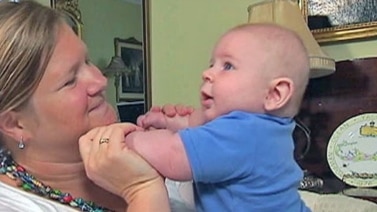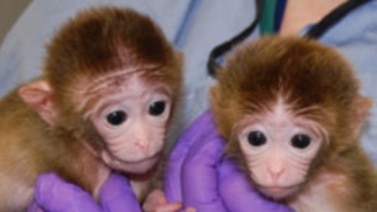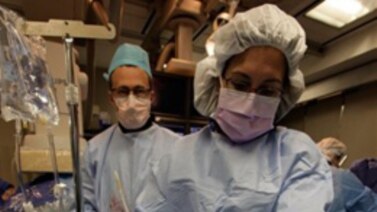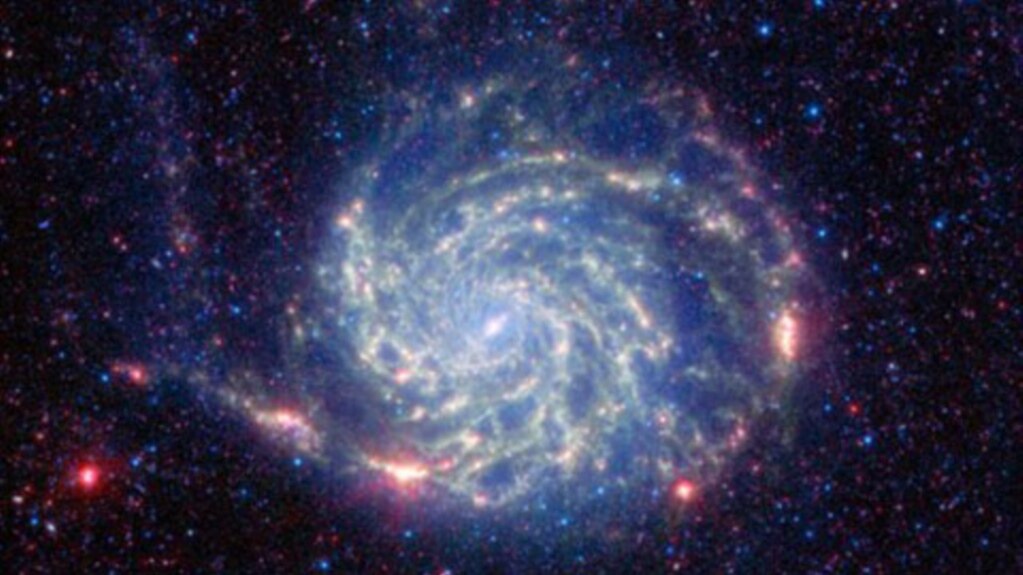
SHIRLEY GRIFFITH: This is SCIENCE IN THE NEWS, in VOA Special English. I’m Shirley Griffith.
STEVE EMBER: And I’m Steve Ember. Today, we tell about the discovery of what astronomers are calling the youngest type 1a supernova ever observed. We tell about an effort to improve the diet of New York City schoolchildren. We also tell why some chili peppers are hotter than others, and how listening to music can ease pain.
(MUSIC)
SHIRLEY GRIFFITH: Two teams of astronomers say the quick discovery of a supernova has helped to solve several mysteries in astronomy. Supernovas are intensely bright exploding stars. Astronomers sometimes use such explosions to measure distance in the universe.
The two teams recently reported findings from what they are calling the youngest type-1a supernova ever observed. They say the findings supported some long-held theories about what kind of stars explode to create supernovas.
STEVE EMBER: The scientists say the research provided the first evidence that small, dense dying stars called carbon-oxygen dwarfs become type 1a supernovas. These white dwarfs are often members of binary star systems. Such a system has two stars that orbit each other. A white dwarf explodes as a type 1a supernova when it takes too much material from its neighbor.
The young type 1a supernova was discovered in August. It is in the Pinwheel Galaxy, about twenty-one million light years from Earth. A light-year is the distance light travels in one year -- about ten trillion kilometers. That may sound like a great distance. But this galaxy is somewhat close to our own Milky Way galaxy. The nearness of the huge event helped scientists make detailed observations.
SHIRLEY GRIFFITH: Type 1a supernovas all release about the same amount of light. That helps astronomers know how far away they are from Earth. So, bright type 1a supernovas are closer than not-so-bright ones.
The astronomers say they discovered the supernova only eleven hours after the star exploded. They say this was the first time a star’s thermonuclear explosion has ever been observed so soon after it happened.
Scientists from the University of California at Berkeley and the California Institute of Technology were among the teams that carried out the research. Two related reports about the supernova were published in the scientific journal Nature.
(MUSIC)
STEVE EMBER: The Centers for Disease Control and Prevention says every third adult and almost every fifth child in America is obese. But health officials in New York City say their work has caused rates of those seriously overweight to drop sharply.
Alex Schimke is a sixth grade student who is not obese. He says he likes fruits, especially strawberries. But like most children, he loves cakes, candy and other sweets.
ALEX SCHIMKE: “Are you going to eat the cake or are you going to eat the apple for health? You’re obviously going to eat the apple, but you want the cake.”
Why the cake and not the apple?
ALEX SCHIMKE: “Because it’s yummy!”
SHIRLEY GRIFFITH: New York City Health Commissioner Thomas Farley knows children love foods that are sometimes not good for them.
THOMAS FARLEY: “Children have a natural preference for sweets, more so than adults. On the other hand, as adults, we choose what to put in front of our children.”
Dr. Farley says New York has increased the amount of physical activity in schools, and improved the food available in school cafeterias. Alex Schimke has noted the difference.
ALEX SCHIMKE: “They do have apples. Oh, yes! And they have a salad bar.”
Alex also noted that vending machines at the school now sell vitamin water instead of sugary drinks.
STEVE EMBER: Dr. Farley says obesity rates in America began rising about thirty years ago. In the twentieth century, many people stopped doing physical labor on farms and in factories. They began working in offices, where they spend most of the time sitting down.
THOMAS FARLEY: “Physical activity has all but disappeared out of most people’s lives, unless they make it a separate task. At the same time, and even more important, food has increasingly become cheap, ready to eat, available everywhere, and so people have adopted habits to sort of snack constantly.”
Dr. Farley says the total childhood obesity rate in New York is still a too-high twenty percent. But he says he is happy that it has fallen at all. And for the first time in many years the rate is down to ten percent among five and six year olds. Dr. Farley says he believes that may mean those children will eat healthy throughout their lives.
(MUSIC)
SHIRLEY GRIFFITH: For spicy food lovers, hot peppers, or chilies, are a great addition to any meal. There are many different kinds of hot peppers. Some are much hotter than others. But what makes some chilli peppers so hot and others not?
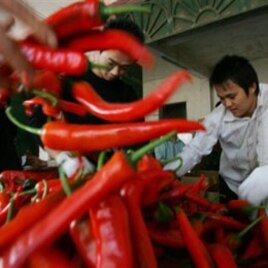
An American researcher has found answers to some of the questions about a pepper’s intensity. Joshua Tewksbury works at the University of Washington in Seattle. For years, he has studied the small, dried fruit of pepper plants during travels to Central and South America. Among his favorites is the Capsicum chacoense, found in Bolivia. Like many chilies, this one can be destroyed if a fungus enters the pepper through holes made by insects. This organism is called Fusarium.
STEVE EMBER: To fight off the attack, the pepper produces a chemical called capsaicin. This is the same chemical that gives peppers their heat. However, not every pepper contains capsaicin. Even within one pepper plant, there may be some peppers with capsaicin and others without it. Those containing the chemical are protected from the fungus.
So why do only some peppers produce capsaicin? That is the question Professor Tewksbury set out to answer. With the help of an assistant, he collected more than three hundred chili plants from a three-hundred-kilometer area in Bolivia. Within this area were different climates. Some plants grew in desert-like conditions, while others were from a very wet climate.
SHIRLEY GRIFFITH: Professor Tewksbury and his assistant found that among the chilies growing in the dry places, only about fifteen to twenty percent were hot. By comparison, one hundred percent of the chilies growing in wet conditions were hot.
They also found that hot chilies growing in dry areas need more water. Because the fungus is less of a threat in dry weather, the chilies in those areas were less likely to produce the heat-making capsaicin. In wet areas, the pepper produced more capsaicin to defend itself.
STEVE EMBER: The researchers tested their findings back at the University of Washington. Three hundred thirty chili plants were grown under the same conditions. Then they were separated into two groups. One received a lot of water. The other plants received the amount of water they would get in a dry climate in Bolivia.
The researchers found that the hot peppers use up more water as a way to protect themselves from fungus. Their findings were published in the Proceedings of the Royal Society B.
(MUSIC)
SHIRLEY GRIFFITH: Maybe a little of this [music] ... or that [music] ... or even this [music] ... could be just what the doctor ordered.
Music seems to have a magical power when it comes to easing pain. This is what researchers at the University of Utah Pain Research Center have found. They reported results of their latest study in the Journal of Pain.
STEVE EMBER: The researchers asked one hundred forty-three people to listen to music while they were being given an electrical shock to the finger. The test subjects were told to listen carefully and note any sounds that were pleasing, or any that seemed to be different from the others.
The researchers measured how the patient’s brain reacted during the experiment. They also watched their eyes for evidence of any reaction to the pain. Some of the test subjects said they were very nervous about feeling pain. These people were said to have high anxiety. Others said they had no great fear of feeling pain.
SHIRLEY GRIFFITH: The lead researcher was David H. Bradshaw of the University of Utah in Salt Lake City. His team found that listening to music seemed to reduce the amount of pain some people feel. They also found that those people with high anxiety were helped most by the music. The researchers had feared that those most afraid of pain would not be able to listen carefully to the sounds they were hearing. But that was not the case.
So, if listening to music helps to lessen pain, what kind of music should we listen to? Mr. Bradshaw says the kind of music is not important. He says the most important thing is to listen to the music very carefully, almost as if you were studying for some kind of musical test.
The Utah researchers believe that music may affect some pathways in the human brain. They think musical sounds activate, or turn on, sensory pathways. If the pathway is being used by the senses, like hearing music, it cannot be used to make that part of the brain feel pain.
(MUSIC)
STEVE EMBER: This SCIENCE IN THE NEWS was written by Brianna Blake, Christopher Cruise and Jim Tedder. Our producer was June Simms. I’m Steve Ember.
SHIRLEY GRIFFITH: And I’m Shirley Griffith. Join us again next week for more news about science in Special English on the Voice of America.
Correction: A summary published earlier with this story incorrectly said a supernova was found twenty minutes after it happened. Astronomers discovered it within eleven hours, but estimated the time of the explosion to within twenty minutes.

